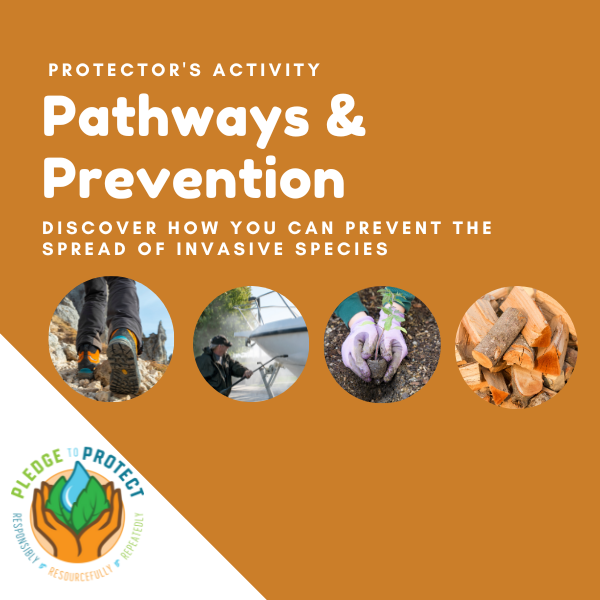What's The Issue?
Did you know that you can spread invasive species by boating, taking a hike, gardening, moving firewood, and many other activities you may enjoy?
There are simple actions you can take to prevent the introduction and spread of invasive species while enjoying these activities.
Join events and tune into webinars to learn ways you can prevent the introduction and spread of invasive species from June 5th through the 11th, during New York’s Invasive Species Awareness Week (NYISAW). Visit nyis.info to get details.
Follow These Actions to Prevent the Spread of Invasive Species

While Boating
The Issue: Aquatic invasive species (AIS) clog waterways, impede aquatic recreation, reduce waterfront property values and have many negative impacts on aquatic ecosystems and wildlife. AIS can easily hitchhike on watercraft, trailers, fishing equipment. You can unknowingly spread AIS to other waterbodies where they can easily spread.
Prevention Steps:
- Clean: Clean whatever comes in contact with the water, this includes your boat and trailer as well as, life jackets, fishing line and tackle, boat fenders, anchor, and anchor lines. As soon as you pull your boat out of the water, take a walk around the trailer and remove any plant debris you can see.
- Drain: Drain and empty live wells, bait buckets, and bilge water, and lower your boat motor as you are preparing your trailer before you leave the boat launch area.
- Dry: Dry your vessel, equipment, and fishing tackle for a minimum of 5 days before launching in a different body of water. Dry all parts of your boat. Zebra Mussel eggs can live out of the water for 5 days and an adult Zebra mussel can live out of water for 2 weeks. By ensuring proper dry time, you can significantly reduce the likelihood that aquatic invasive species will survive and be spread to other water bodies.

While Hiking
The Issue: The tread of your shoes can pick up plant seeds and even microscopic organisms; pets can get plant seeds attached to their fur that can easily spread to areas you explore or travel back home with you.
Prevention Steps:
- Use a boot brush to clean the tread of your shoes before and after hiking. Many trails have installed boot brush stations at their trailheads for public use. Handheld boot brushes can also be purchased from the PlayCleanGo store.
- Check your pets for any seeds that may have attached to their fur and give them a bath after hiking. Be sure to check them and yourself for ticks as well!

While Using Firewood
The Issue: Invasive insects like the emerald ash borer, and long-horned beetle can easily hitchhike inside firewood. The larvae of these insects burrow tunnels in the wood, pupate and emerge as adults. Invasive tree pests cause tree mortality and can significantly impact the overall health of natural and urban forests.
Prevention Steps:
- Source Local Firewood: In New York State there are regulations against moving firewood more than 50 miles from where it originated. While camping, be sure to not bring unused firewood home or to bring firewood that was sourced more than 50 miles from where you will use it.
- Buy Certified Heat-treated Firewood: To be considered “treated firewood” in New York, a government certified facility must subject the firewood to a heat-treatment process that is hot enough – and for long enough – to kill any pests in the wood (in New York this standard is 71° C (160° F) for 75 minutes).
- Learn more about firewood regulations and best use practices in this Protector’s Activity Blog.

While Gardening
The Issue: Many invasive plants were once considered desirable ornamentals that were intentionally introduced to our gardens and landscapes only to escape into our natural environments. Once established, invasive species easily outcompete native species which reduces the availability of food and shelter for native wildlife and hinders the functionality of natural systems.
Prevention Steps:
- Choose Native Alternatives: You can play a vital role in the introduction and the prevention of invasive plants by choosing to grow native plants in your yard rather than exotic, non-native and invasive plants.
- Learn about native alternatives to common invasive plants in this Protector’s Activity Blog.
Celebrate New York’s Invasive Species Awareness Week (NYISAW) June 5th through the 11th.
Visit nyis.info to learn about in-person and virtual events you can join to learn more ways to prevent the introduction and spread of invasive species.
Virtual Toolboxes
Visit the Protector’s Virtual Toolboxes below to access resources themed for each category, and to learn more about how to protect your favorite outdoor spaces from invasive species.
Lands & Trails
Lands & Trails
Forests
Waters
Gardens
Communities
Did you enjoy this blog post? Take our Pledge to Protect and get monthly emails showcasing actions you can take to protect your favorite hiking trails, paddleways, forests, garden, and community from the impacts of invasive species!
Take the Pledge to Protect
The Pledge-to-Protect is a fun, positive, inviting, engaging and rewarding way to participate in invasive species prevention and management.
|
|




